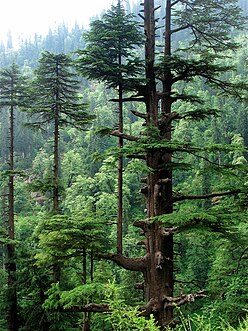Western Himalayan subalpine conifer forests
| Western Himalayan subalpine conifer forests | |
|---|---|

Cedrus deodara in Manali Sanctuary
|
|
| Ecology | |
| Biome | Temperate coniferous forests |
| Borders | |
| Bird species | 315 |
| Mammal species | 102 |
| Geography | |
| Area | 39,700 km2 (15,300 sq mi) |
| Countries | India, Nepal, Pakistan and Afghanistan |
| Conservation | |
| Habitat loss | 62.318% |
| Protected | 6.18% |
The Western Himalayan subalpine conifer forests is a temperate coniferous forests ecoregion of the middle and upper elevations of the western Middle Himalayas of Nepal, India, and Pakistan.
The ecoregion forms a belt of coniferous forest covering 39,700 square kilometres (15,300 sq mi) on elevations between 3,000 and 3,500 metres (9,800 and 11,500 ft). It extends west from the Gandaki River in Nepal, through the Indian states of Uttarakhand and Himachal Pradesh, and into Jammu and Kashmir eastern Pakistan. This belt of conifers is the highest expanse of woodland to be found on the slopes of the Himalayas, treeless alpine scrub lying just above its ecotopic frontier. It is a valuable ecosystem as many Himalayan birds and animals migrate seasonally up and down the mountains spending part of the year in the conifer forests, so conservation is a high priority.
This ecoregion is drier than the Eastern Himalayan subalpine conifer forests, which receive more moisture from the Bay of Bengal monsoon.
Several distinct forest types are found in this ecoregion. Fir trees (Abies spectabilis) in places grow in nearly pure stands. In other areas they mix with oaks (Quercus semecarpifolia). Rhododendron campanulatum, Abies spectabilis, and birch (Betula utilis) form another common assemblage. Elsewhere mixed-conifer forests are made up of Abies spectabilis, blue pine (Pinus wallichiana) and spruce (Picea smithiana). Cupressus torulosa and Cedrus deodara are also found here. A recently published major new monograph, Conifers Around the World, treats the high-level western Himalayan fir tree as Abies gamblei (apparently, A. spectabilis does not reach this region!)
...
Wikipedia
